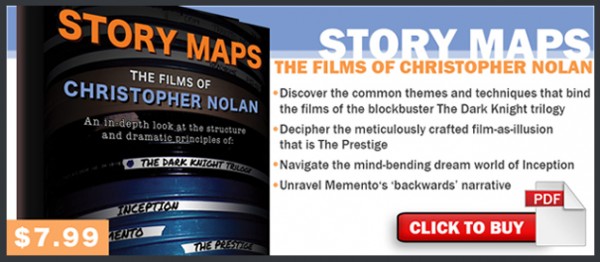Interstellar: 5 Christopher Nolan Trademark Techniques
Christopher Nolan is the most daring film director working in the major studio system today, and each film he directs becomes an event. With Interstellar, he’s created (along with his co-writer, brother Jonathan Nolan) an epic that combines classic Hollywood storytelling with bold narrative choices, all displayed with cutting-edge theatrical presentation. Interstellar is certainly his BIGGEST film yet, not just in cinematic scope but in the size of the narrative stakes and thematic resonance, and makes me wonder how the hell he’s going to top it with his next movie!
Here are five techniques that Christopher Nolan uses to great success in Interstellar.
1) Relevance to today’s world. Just as he did with the ‘War on Terror’ parallels in The Dark Knight, Nolan delivers a timely story in Interstellar. Cooper’s (Matthew McConaughey) haunting words “We used to look up at the sky and wonder at our place in the stars, now we just look down and worry about our place in the dirt” encapsulate Nolan’s view of a ‘dystopian’ future in which imagination and the spirit of exploration have perished in the fight for survival on a dying planet. It is a more intelligent and prescient view of our world than most of the dystopian genre films we are given these days. Interstellar’s Earth is not about teens fighting to the death on television or zombies roaming the landscape in search of tender flesh – it is about what could happen to our planet if we continue to ignore the warning signs and we lose the passion that moved President John F. Kennedy to say “We choose to go to the moon in this decade…not because they are easy, but because they are hard.”
In our time of polarized and paralyzed politics and millions fighting over nothing but ideology, Interstellar is a call for humanity to pull together and dream bigger. Together.
It occurs to me that there is an irony to a lot of the criticism leveled at the film. Many critics have focused purely on attacking the science of the film, forgetting that it’s Science FICTION. In other words, they left their imagination at the theater door, which is exactly what the film is warning us about.
2. Compression of Time. Nolan knew that we’d be coming to the theater to see epic space travel sequences, not an hour of exposition, so he made sure to get Cooper and crew on that rocket as quickly as possible. Who needs a training sequence or a bunch of “get to know ya” scenes when you’ve got an IMAX wormhole to get to? In an earlier draft of the screenplay, Cooper and Murph fly to the NASA site in his piper cub airplane. In the film, NASA is within driving distance.
Another great example of this technique is in The Dark Knight Rises when Bruce Wayne rehabs his broken back in mere seconds of screen time. With an old rope. It works, because we just want to see Batman get back to Gotham City so he can go kick Bane’s ass.
3. Emotional Monologue from a supporting character that challenges the core of the protagonist. When Cooper and Brand (Anne Hathaway) are faced with an impossible decision between the head and the heart, Brand delivers a powerful monologue that argues that love can be just as legitimate of evidence to support a life-changing decision as raw scientific data. Cooper chooses the data. As we see later in the film, she was right.
4. Fractured Timelines. Interstellar is not quite Memento or The Prestige when it comes to fractured structure, but since it has to do with travel through worm holes and black holes, which bend time and space, some level of playing with time was inevitable. The second half of the film does a fantastic job of building tension by cross-cutting between Cooper in space and Murph (Jessica Chastain) back on Earth. My favorite bold time jump in the film comes when Cooper and Brand get back to The Endurance space station to find their compatriot Doyle, looking worse for wear, as he has been waiting for them for a very, very long time. (I can’t help but wonder, though, what was he eating that entire time?)
5. Pushing the IMAX envelope. Nolan pioneered the use of IMAX cameras in narrative film with The Dark Knight, and he has continued to use the technology more and more with his follow-up films, Inception and The Dark Knight Rises. He has also inspired a few of his contemporaries to use IMAX to fantastic effect, most notably in Mission: Impossible: Ghost Protocol and Skyfall. But no one can touch Nolan on the IMAX front, and with Interstellar, he’s taken it to a new level by switching back-and-forth between formats within the same scene. Previously, IMAX footage was only spliced into a film in whole unbroken sequences, not inserted shot-by-shot into a scene. Until now. You may not have even noticed as the screen jumped back-and-forth between normal widescreen format and IMAX, and that’s the point. The effect is seamless.
If you’d like to learn more about Nolan’s incredible storytelling methods, I invite you to pick up my e-book, STORY MAPS: The Films of Christopher Nolan (co-written with William Robert Rich) on my site or on Amazon, or listen to my podcast discussion with Steve Lam on Interstellar here.
Good Luck and Happy Writing!
Dan Calvisi





“(I can’t help but wonder, though, what was he eating that entire time?)”
I think you missed the part where he said he was asleep some of the time.